Flanked by the Arabian Sea and the western ghats on the southwestern coast of Indi, Kochi is a lovely seaside city and the ideal starting point for a tour of Kerala. The culture and architecture of this Indian gem have been shaped by those who have occupied the city in its turbulent past, including the Arabs, British, Chinese, Dutch and Portuguese.
At the beginning of the 12th century, Kochi was the seat of the Kingdom of Cochin, a princely state which traces its lineage o the Kulasekhara empire. It became an important spice-trading centre in the 14th century, dealing in pepper, cardamon, cinnamon, cloves and other products native to the area's lush soils.

Occupied by the Portuguese in 1503, Kochi was the first European settlement in India and remained the capital of Portuguese India until 1530. The city was later occupied by the Dutch, the Mysore and the British. It was the Princely state to willingly join the Indian Union after independence in 1947.
Kochi boasts many cultural treasures and historical buildings, including St Francis' Church, the oldest European church in India and the burial place of Vasco da Gama, the Portuguese explorer who died in 1524. Vasco House, on Rose Street, is thought to have been his former home.
With its glass-paned windows and sweeping verandahs, it is one of the oldest Portuguese homes in the country. Santa Cruz Cathedral was built by the Portuguese in 1505 but destroyed by British invaders in 1795. It was rebuilt in 1905 and is famous for its painted ceilings.
Built by the Portuguese in 1555, Mattancherry Palace was gifted to the Raja of Cochin, Veera Kerala Varma, partly as compensation for a temple they had demolished, and partly as a bribe to gain favours. The Dutch took over the Palace in 16663 when they took Cochin from the hands of the Portuguese and made it into what it is today. Its single exterior belies its very decorative interior. The central hall on the first floor was the Coronation Hall of the Rajas, and their dresses, turbans and palanquins are on display.

The Raja gave the area known as 'Jew Town' to the Jewish community to protect against their persecution. The Paradest Synagogue, built in 1568m is magnificently decorated with Chinese tiles and Belgian chandeliers.
Another noteworthy sight is Kalady, on the banks of the River Periyar, the birthplace of Sri Adi Sankaracharya the Hindi philosopher. The Adi Sankara shrine and eight-storey painted Adi Sankara Keerthi Sthambam are a must-see for any visitor.



 Click it and Unblock the Notifications
Click it and Unblock the Notifications






















